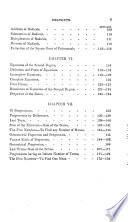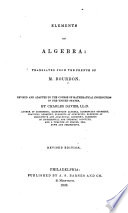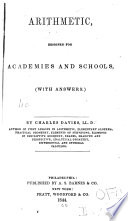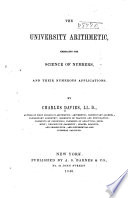 ... that is, Any term of a geometric series is equal to the product of the first term, by the ratio raised to a power, whose exponent is one less than the number of terms. EXAMPLES. 1. ... that is, Any term of a geometric series is equal to the product of the first term, by the ratio raised to a power, whose exponent is one less than the number of terms. EXAMPLES. 1.  New Elementary Algebra - Page 276by Benjamin Greenleaf - 1879Full view New Elementary Algebra - Page 276by Benjamin Greenleaf - 1879Full view - About this book
 | Daniel Adams - Arithmetic - 1848 - 322 pages
...the first term, number of terms, and ratio of an increasing series are given, to find the last term, RULE. Multiply the first term by the ratio raised to a power one less than the number of terms. NOTE 1 . — To get a high power of a number, it is convenient to... | |
 | Charles Davies - Algebra - 1835 - 378 pages
...precede it. That is, the last term of a geometrical progression is equal to the first term multiplied ' by the ratio raised to a power whose exponent is one less than the number of terms. For example, the 8lh term of the progression 2 : 6 :. 18 : 54 . . ., is equal to 2x37=2x2187=4374.... | |
 | Algebra - 1838 - 372 pages
...precede it. That is, the last term of a geometrical progression is equal to the first term multiplied by the ratio raised to a power whose exponent is one less than the number of terms. 1. Find the 5th term of the progression 2 : 4 : 8 : 16, &c, in which the first term is 2 and the common... | |
 | Charles Davies - Arithmetic - 1838 - 292 pages
...first term, the common ratio, and the number of terms, to find the last term. RULE. Raise the ratio to a power whose exponent is one less than the number of terms, and then multiply the power by the first term, the product will be the last term. EXAMPLES. 1. The... | |
 | Charles Davies - Algebra - 1839 - 272 pages
...precede it. Hence, to find the last term of a progression, we have the following RULE. I. Raise the ratio to a power whose exponent is one less than the number of terms. II. Multiply the power thus found by the first term: the product will be the required term. QUEST.... | |
 | Charles Davies - Algebra - 1842 - 368 pages
...precede it. That is, the last term of a geometrical progression is equal to the f,rst term multiplied by the ratio raised to a power whose exponent is one less than the number of terms. 1. Find the 5th term of the progression 2:4:8:16, &c, in which the first term is 2 and the common ratio... | |
 | Charles Davies - Algebra - 1842 - 284 pages
...precede it. Hence, to find the last term of a progression, we have the following RULE. I. Raise the ratio to a power whose exponent is one less than the number of terms. II. Multiply the power thus found by the first term: the product will be the required term. QUEST.... | |
 | Charles DAVIES (LL.D.) - Arithmetic - 1843 - 348 pages
...first term, the common ratio, and the number of terms, to find the last term. RULE. Raise the ratio to a power whose exponent is one less than the number of terms, and then multiply the power by the first term, the product will be the last term. EXAMPLES. 1. The... | |
 | Charles Davies - Arithmetic - 1844 - 666 pages
...first term, the common ratio, and the number of terms, to find the last term. RU1E. Raise the ratio to a power whose exponent is one less than the number of terms, and then multiply the power by the fa-st term, the product mil be the last term. EXAMPLES. 1. The first... | |
 | Charles Davies - Arithmetic - 1846 - 370 pages
...given the first term, the common ratio, and the number of terms, to find the last term, Raise the ratio to a power whose exponent is one less than the number of terms, and then multiply the power by the first term : the product will be the last term. EXAMPLES. 1 . The... | |
| |